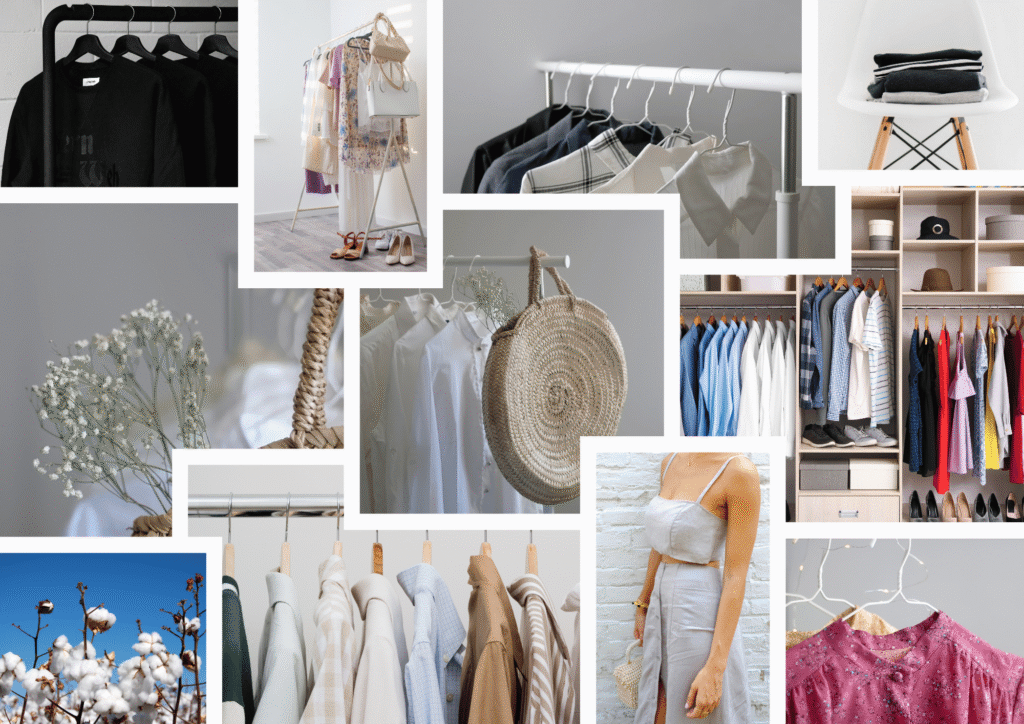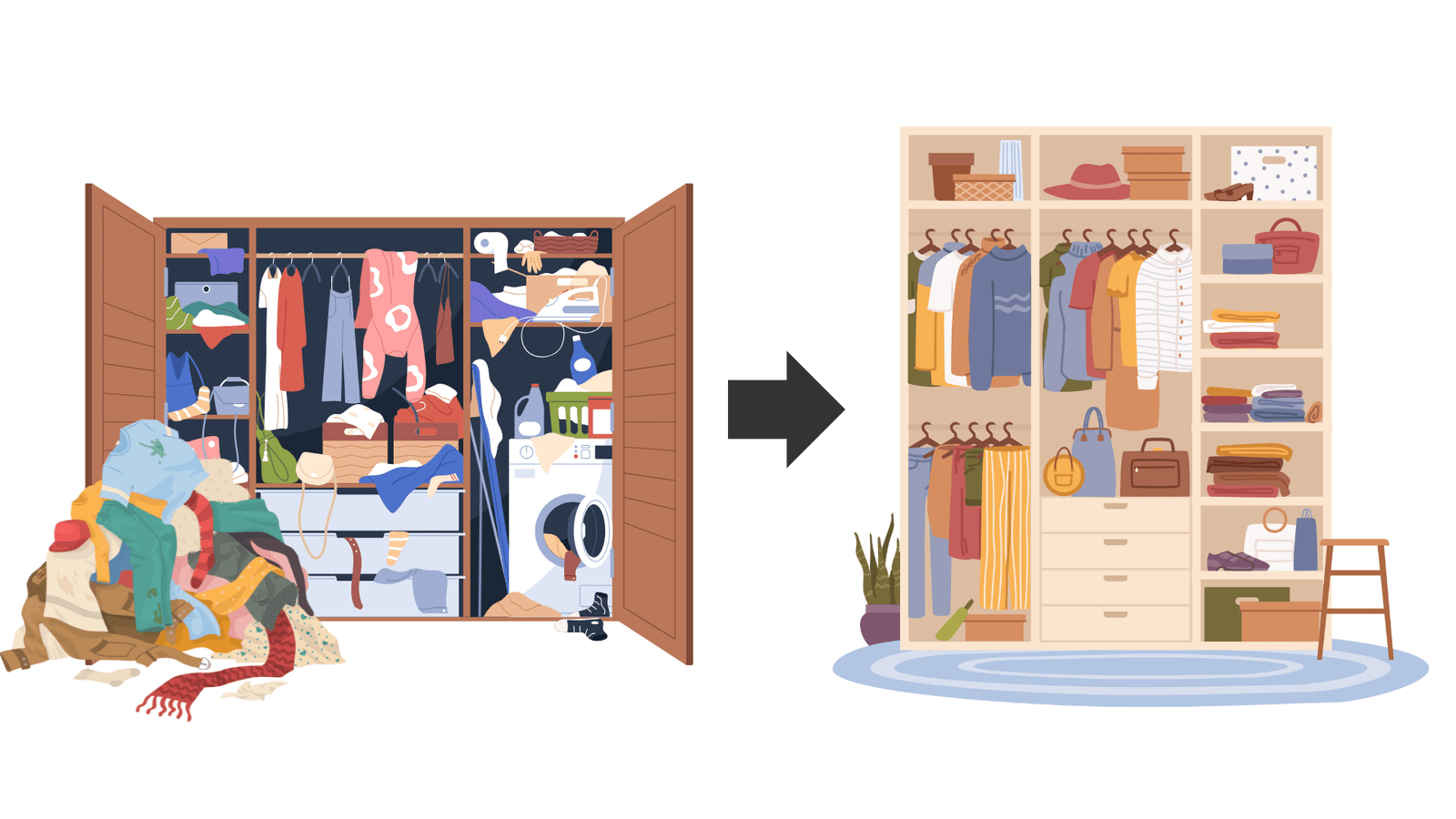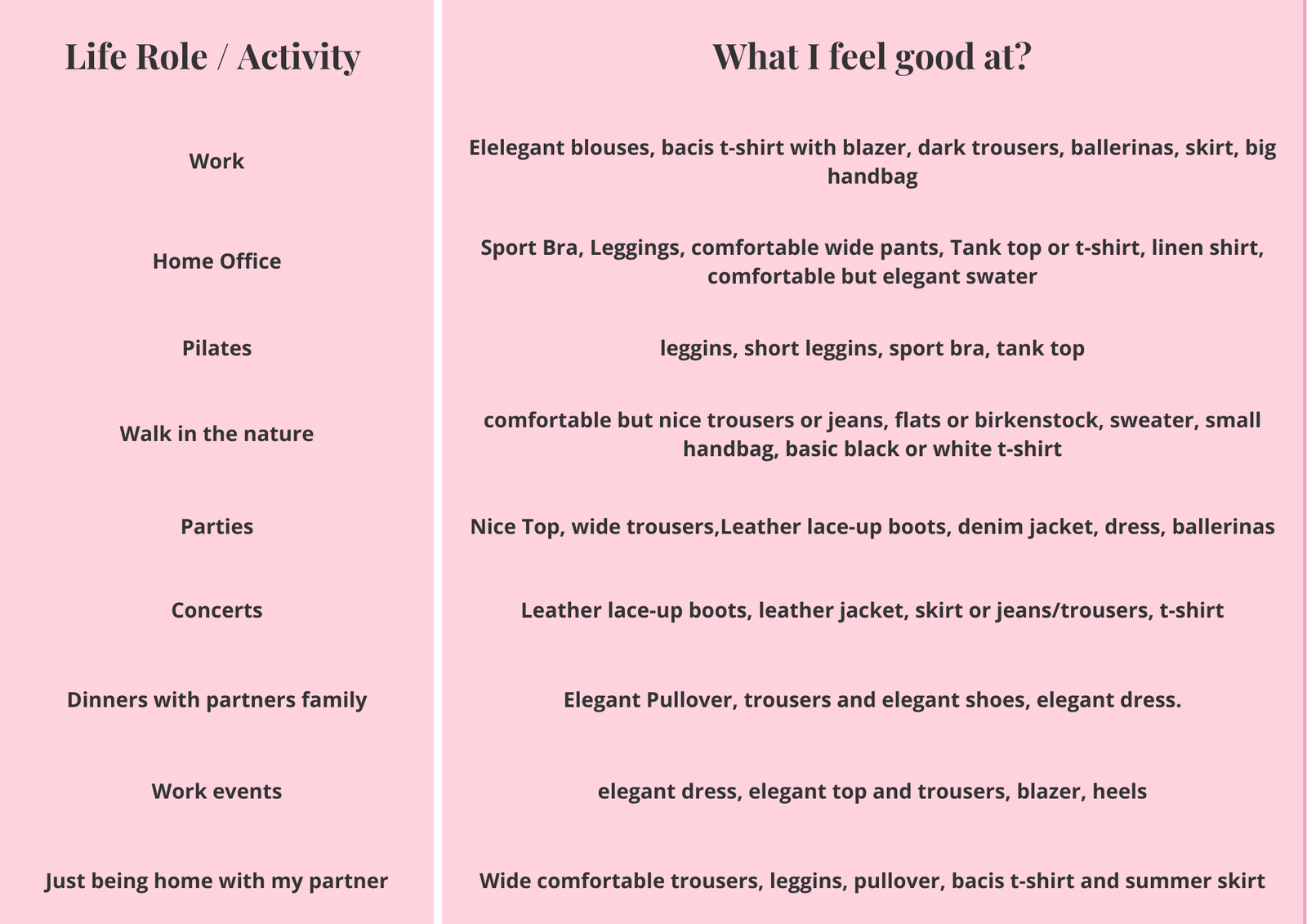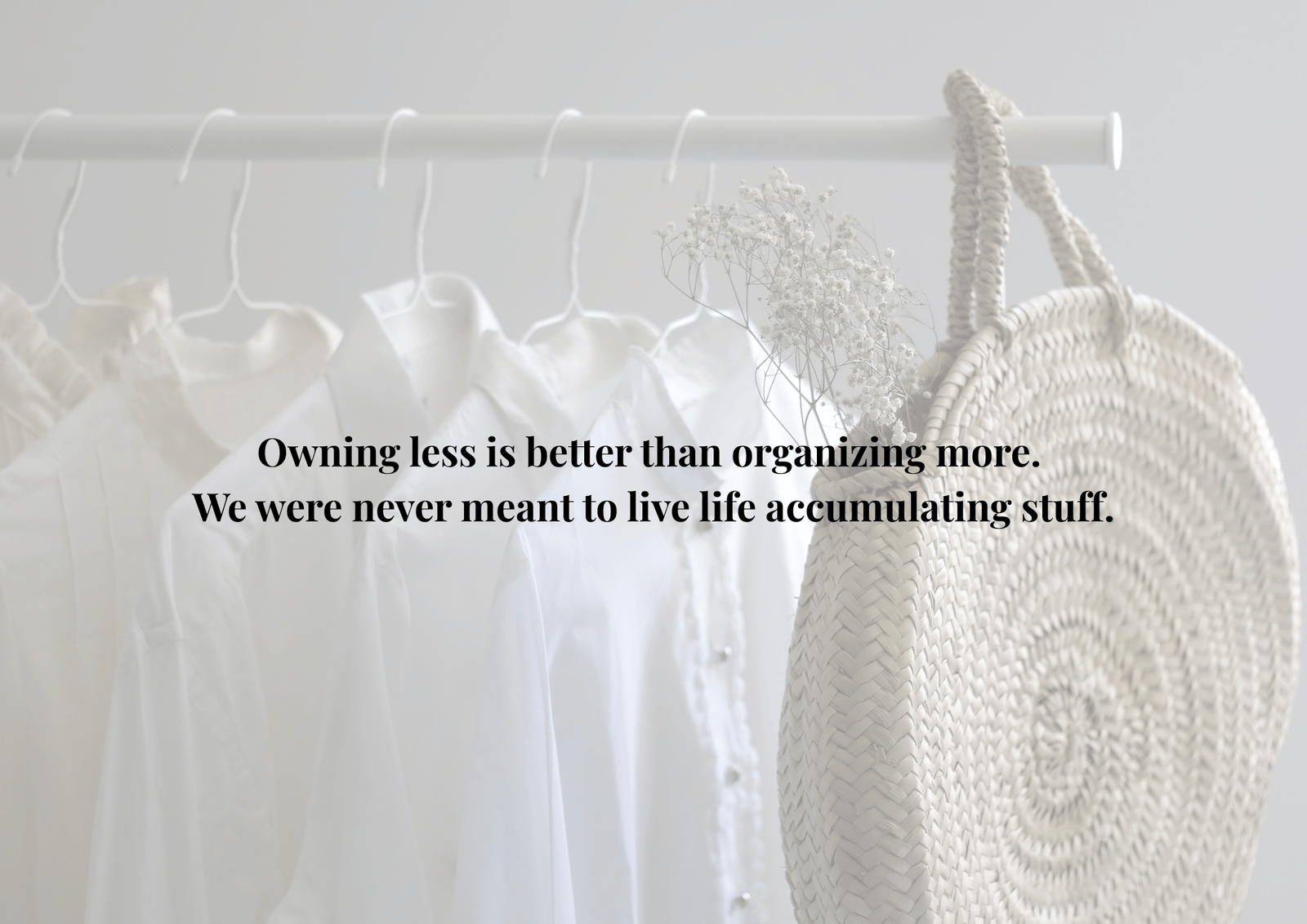THE CAPSULE WARDROBE GUIDE

Why Create an Effective Capsule Wardrobe?
Imagine waking up, opening your closet, and always knowing what to wear. No stress, no impulse purchases, and no chasing after trends that disappear within weeks. That’s one of the biggest benefits of building a capsule wardrobe: peace of mind.

Trends are designed to keep us shopping. What’s “in” today often looks outdated next month. Fast fashion profits from our constant need to stay up to date, making us believe we’re never stylish enough. But when you embrace a more intentional approach, you no longer need to keep up. You look great because you know what suits you — and your wardrobe supports that.
You save money, you save time, and you develop a personal style that lasts. And as a bonus, you help the planet.
Step 1: Rethink Your Needs and Habits
Before you change your wardrobe, look at your life. What clothes do you wear often? How many roles do you play each week – professional, casual, sporty, social? Make a list of typical activities and the outfits you use.
Use this to build a moodboard – a visual guide to your true style. Collect images of clothes, fabrics, and colors that speak to you. Don’t think about trends. Just focus on what feels like you.

Ask yourself:
- Which outfits make me feel comfortable and confident?
- What do I wear again and again?
- What do I never reach for, and why?
- What events do I attend? What do I do in my free time? Where do I go?
- What kind of clothes do I wear there, or would I like to wear?
If you live in a region where the weather stays mostly the same all year round, you have a natural advantage. But if your climate includes both tropical summers and snowy winters, consider making separate wardrobe plans for each season. Some items may work year-round, but others will need to be season-specific.
These questions help you identify what you truly need – and what you don’t.

You might discover that jeans or wide-leg trousers are a foundation of your wardrobe. If so, consider having 2-3 well-made pairs in your closet at all times. Quality matters more than quantity here. On the other hand, you may notice you own several skirts but rarely wear them. Then it’s worth asking: do I really want to wear skirts, or do I have nowhere suitable to wear them? Either way, you might not actually need them.
Step 2: Detox and Audit Your Closet
Start with a shopping detox. Give yourself a break from new purchases for a month or more. During this pause, observe how often you reach for certain items, and which ones stay untouched. You’ll quickly see what actually serves your life – and what doesn’t.
Then move to a full wardrobe audit. Pull everything out. Yes, everything. Lay it on your bed, or sort by category. Try things on. Take notes on how each piece fits, feels, and functions.
Ask:
- Would I buy this again today?
- Does this still fit my style and lifestyle?
- Does it make me feel good when I wear it?
Make a list or table (like the one shown earlier) based on life activities and what you wear for each. This helps clarify real needs.
Many people discover they already have much of what they need, and also spot gaps – like lacking good outerwear or enough basics. This step isn’t just about what to keep or toss. It’s about understanding how your wardrobe is working for you (or not).
Step 3: Declutter with Purpose
Don’t throw away high-quality pieces too quickly. Fashion trends come and go, and well-made items deserve to be preserved. You might want to wear them again in five years – and if the quality is good, they’ll still be ready. The same goes for evening wear: even if you only use it once a year, it’s worth keeping.
Decluttering isn’t about minimalism for minimalism’s sake. It’s about creating a wardrobe that works. One that reflects your actual needs, not what marketing told you last season.
Use these categories:
- Keep: Things that fit, feel good, and are worn often.
- Donate or Swap: Items in good condition that no longer serve your life or style.
- Recycle or Compost: Anything damaged beyond repair or made from biodegradable materials.
Avoid saving clothes “just in case” – that’s how clutter builds. If you haven’t worn it in the last year and can’t imagine wearing it next week, it’s likely time to let it go.
Pro Tips:
- Host a clothing swap with friends
- Look for textile recycling points in your city
- Learn simple repairs to revive pieces you like
Letting go of clothes can feel difficult – but remember, you’re not losing value. You’re gaining clarity, space, and confidence in what remains.

Step 4: Define a Functional Capsule Wardrobe
Think of your closet as a toolbox. You need different tools (clothes) for different jobs (roles). A well-planned wardrobe often contains around 35-40 pieces that cover all seasons and situations.
Suggested categories:
- 3-5 tops for work
- 2-3 casual tops
- 2 pairs of jeans
- 2 pairs of trousers
- 1-2 dresses (if you wear them)
- 1 warm coat
- Layering pieces: sweaters, cardigans
- Comfortable shoes
- Underwear and pajamas
Add accessories to personalize your looks. Focus on neutral colors that can mix and match easily.
Build from the Inside Out
Start with underwear and loungewear. Then add everyday clothes. Finish with seasonal and statement pieces.
Step 5: Smart, Intentional Shopping
When it’s time to buy something new:
- Choose timeless over trendy
- Look for natural, durable materials
- Read care labels and check for one-material garments (better for recycling)
- Avoid impulse buys: wait 3-7 days before purchasing
Ask:
- Can I wear this at least 30 times?
- Does it go with 3+ things I already own?
- Does it reflect my personal style?
Also, consider renting or borrowing clothes for rare events.
Step 6: Care to Make It Last
Clothes last longer with proper care:
- Wash less often
- Use eco detergents
- Skip the dryer
- Air dry on hangers
- Store folded knits and hanging jackets
Learn basic repairs like sewing a button, fixing a hem, or patching small holes. These small habits extend the life of your wardrobe and reduce waste.
Step 7: Shop Local and Ethical
Small local makers often use high-quality materials, simply because they produce in small batches and aim for long-term customer satisfaction. When possible, support these businesses. Their products are usually made with more care, better craftsmanship, and fabrics that feel and wear better over time.
Support local makers, second-hand stores, and small ethical brands. Look for:
- Transparent production
- Living wages
- Safe working conditions
- Organic or recycled materials
- Minimal packaging
Favor companies that align with your values. Choose brands that focus on environmental impact and social justice, not just profit.
TIPs for 99 Sustainable Clothing Brands By Budget (2025)
Step 8: Think Circular
Thinking circular means planning for the full life of your clothes – from purchase to disposal.
Start by choosing items made from one type of material. These are easier to recycle. Natural fibers like cotton, linen, hemp, and wool are best because they decompose naturally and don’t release microplastics.
When you’re done with a piece:
- Reuse: Turn it into rags or upcycle into something new.
- Resell or gift: Someone else might love it.
- Compost: Only possible with 100% natural, untreated fibers.
- Recycle: Drop it at a proper textile recycling point.
Circular fashion also includes buying second-hand, renting clothes, or supporting brands that take back worn garments to recycle into new ones.
The goal isn’t zero waste perfection. It’s closing the loop as often and creatively as possible.
Step 9: Slow Down Your Consumption
Marketing pushes us to buy things we don’t need. Take a pause. Learn to live with what you have. Rethink what brings you real joy. True pleasure comes from usefulness, not price or brand.
Instead of buying, try:
- Swapping with friends
- Shopping your closet
- Customizing what you already have
Step 10: Learn to Spot Value
Spotting true value takes practice. It’s not about price – it’s about cost per wear, quality, and how well a piece fits into your lifestyle.
Look for:
- Good seams (tight, even stitching)
- Fabric feel (soft, breathable, not scratchy or stiff)
- Details like buttons, lining, and hems
Ask:
- Can I wear it at least 30 times?
- Does it match with multiple outfits?
- Do I feel like myself in it?
Also consider transparency: does the brand share where and how it produces? Does it use certified materials? Does it offer repairs or resale programs?
Train yourself to ignore red sale tags or trend labels. Instead, listen to your body, your habits, and your actual life. That’s where real value lies.
Final Tip: Buy Fewer, Better Things
Each item in your wardrobe should serve a purpose. If it doesn’t, it’s just clutter. The philosophy of “fewer, better things” is about choosing quality, versatility, and intention over abundance. It’s about making room – in your closet, your budget, and your mind – for only the things that truly matter.
Instead of chasing trends or filling your closet with random pieces, build your capsule wardrobe slowly. Take time to research brands, test materials, and evaluate fit and comfort. Ask yourself: Does this piece reflect who I am? Will it still be relevant to me in a year? Five years?
Better clothes often come with a higher price tag, but they deliver better cost-per-wear. A well-made pair of shoes or a structured blazer worn hundreds of times will always beat five cheaper items that fall apart quickly.
Minimalism in fashion doesn’t mean wearing only black or owning ten items. It means finding a curated collection that works for your life – effortlessly, stylishly, and sustainably.
Choosing fewer, better things is not about restriction. It’s about freedom – the freedom to wear what you love, to let go of the rest, and to stop letting fast fashion dictate your choices.
When you build your capsule wardrobe with intention, each piece becomes part of your personal story. And that is far more powerful than any trend.
In Summary
The journey starts in your capsule wardrobe, but it doesn’t end there. With every mindful choice, you create a more ethical and meaningful life. Let your wardrobe be a reflection of your values – simple, strong, and conscious.
Quick Links:
Discover how the 4 Seasons & 12 Subtypes can help you find your perfect colors in our detailed guide!
